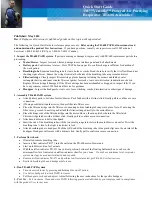
4--3
©
2012 Mobile Climate Control
T-353 Rev. 01/2013
4.4 REMOVING THE REFRIGERANT CHARGE
NOTE
To avoid damage to the earth's ozone layer,
use a refrigerant recovery system whenever
removing refrigerant.
4.4.1 Removing Entire System Charge
To remove the entire refrigerant charge, do the
following:
a. Connect a manifold gauge set to the system as
shown in Figure 4-2 .
b. Connect a reclaimer to the center manifold gauge
set connection.
c. Recover refrigerant in accordance with reclaimer
manufacturers instructions.
D S
7.
2.
3.
4.
5.
6.
To Compressor
1.
Figure 4-2 In-Line Service Connections
1. Discharge Service
Port
2. Suction Service
Port
3. Manifold Gauge
Set
4. Vacuum Pump
5. Reclaimer
6. Refrigerant Cylinder
7. Thermistor Vacuum
Gauge
4.5 REFRIGERANT LEAK CHECK
A refrigerant leak check should always be performed
after the system has been opened to replace or repair
a component.
To check for leaks in the refrigeration system,
perform the following procedure:
NOTE
It must be emphasized that only the correct
refrigerant should be used to pressurize the
system. Use of any other refrigerant will con
taminate the system, and require additional
evacuation.
a. Ensure filter drier service and solenoid valves(if
equipped) are open.
1. Filter drier service valves should be back seated.
b. If system is without refrigerant, charge system
with refrigerant vapor to build up pressure be
tween 20 to 30 psig (1.36 to 2.04 bar).
c. Add sufficient nitrogen to raise system pressure to
150 to 200 psig
(10.21 to 13.61 bar).
d. Check for leaks. The recommended procedure for
finding leaks in a system is with an electronic leak
detector. Testing joints with soapsuds is satisfacto
ry only for locating large leaks.
e. Remove test gas and replace filter-drier.
f. Evacuate and dehydrate the system. (Refer to
paragraph 4.6.)
g. Charge the unit. (Refer to paragraph 4.7.)
4.6 EVACUATION AND DEHYDRATION
4.6.1 General
The presence of moisture in a refrigeration system
can have many undesirable effects. The most
common are copper plating, acid sludge formation,
“freezing-up” of metering devices by free water, and
formation of acids, resulting in metal corrosion. An
evacuation should take place after a system repair
(replacement of filter drier. expansion valve,
solenoid valve, etc).
4.6.2 Preparation
NOTE
Using a compound gauge (manifold gauge) for
determination of vacuum level is not recom
mended because of its inherent inaccuracy.
a. Evacuate and dehydrate only after pressure leak
test. (Refer to paragraph 4.5)
b. Essential tools to properly evacuate and dehydrate
any system include a good vacuum pump with a
minimum of 5 cfm
(8.5 m
3
/hr)
volume displace
ment, (MCC P/N 07-00176-11), and a good mi
cron gauge (MCC P/N 07-00414-00).
Summary of Contents for 68AC430-100
Page 1: ...OPERATION SERVICE for 68AC430 100 REV 01 2013 T 353 Manual T 353 2012 Mobile Climate Control...
Page 30: ...5 2 2012 Mobile Climate Control T 353 Rev 01 2013 98 67037 00 Figure 5 2 Evaporator Motors...
Page 31: ...5 3 2012 Mobile Climate Control T 353 Rev 01 2013 98 67037 00 Figure 5 3 Condenser Motors...
Page 33: ...5 5 2012 Mobile Climate Control T 353 Rev 01 2013 98 67037 00 Figure 5 5 BT324 Control Circuit...
















































